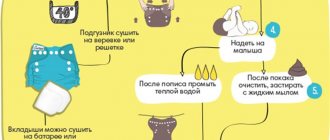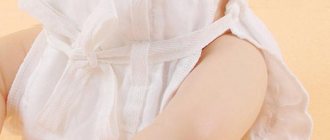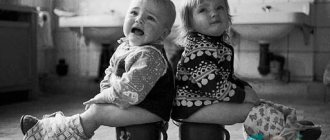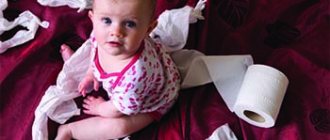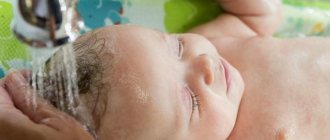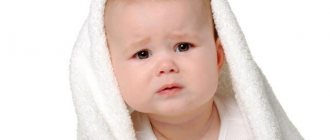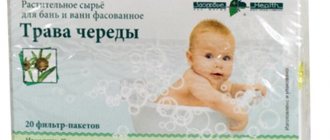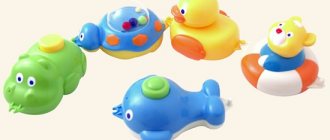How long?
How long will it take to buy diapers, and is there a way to quickly “transplant” a toddler from diapers to a potty?
The best age to wean a child off diapers - how do you know when the time has come?
Normally, by the age of 3-4 years, children should wake up dry and go to the potty.
But the widespread and round-the-clock use of diapers has led today to an increasing number of cases of enuresis in children over 5 years of age.
How harmful diapers are is the second question, today we will look into the question - at what age is it time to stop using them and how to do it as painlessly as possible.
Choosing the right laundry detergent
You should prepare for the fact that you will have to do a lot of laundry.
How to wash reusable diapers is an important question. The best option would be to use a liquid laundry detergent without lanolin, as it has water-repellent properties, which are not at all necessary in this case. Also, make sure that the product does not contain chlorine; it has a destructive effect on the membrane, which can cause the product to get wet. Washing gels are ideally suited for delicate membrane fabrics; they rinse well and retain all the properties of the fabric. But you can also use the most common baby powder. But the manufacturers of reusable diapers do not recommend washing with soap; it clogs the pores of the fabric, and it becomes more difficult for liquids to pass through the diaper pocket to the insert, so the product may absorb less well. The same applies to earbuds. Well, cotton fabric, of course, can be washed with anything, as long as it is not an allergenic product for the baby.
A little note: if there is an unpleasant smell from the diapers, add a little more detergent.
Video: How to wean a child off diapers and potty train - Dr. Komarovsky
How do you know when it's time to wean off diapers?
Newborn babies are not able to restrain the urge to urinate - after filling the latter by more than half, a “wet thing” occurs reflexively.
In a baby under one year old, neither the brain nor the nervous system is responsible for the excretory system of the body.
And only from 18 months does control over the functioning of the rectum and bladder appear. It is from this age that it makes sense to begin the painstaking work of giving up diapers. Before a year and a half, this makes no sense. Naturally, the child himself must “mature” so that the mother does not work alone, and the “cooperation” is effective.
It is worth noting that children 6 months old are able to withstand a dry “break” for a maximum of 3 hours. The child's final control over the bladder appears by the age of 3-4 , and by this age there should no longer be wet tights either at night or during the day.
To summarize, we can say that the ideal age for transferring a baby to a potty and giving up diapers is 18-24 months.
How to understand that the baby is “ripe”?
- Urination occurs at specific intervals. That is, about (for example, after sleep, after eating, after a walk).
- The baby is able to take off his pants himself.
- The baby notifies his parents when he wants to go small (or big) - with gestures, sounds, etc.
- The child understands the words pee/poop/potty.
- The baby shows dissatisfaction with an overfilled or soiled diaper , as well as wet tights.
- The diaper regularly remains dry even after 2-3 hours of wear.
- The child is interested in the potty , constantly sits on it, and also places his toys on it.
- The child constantly pulls off the diaper or actively protests against putting it on.
If you notice these signs of another stage of growing up in your baby, then you can gradually put the diapers away in the closet.
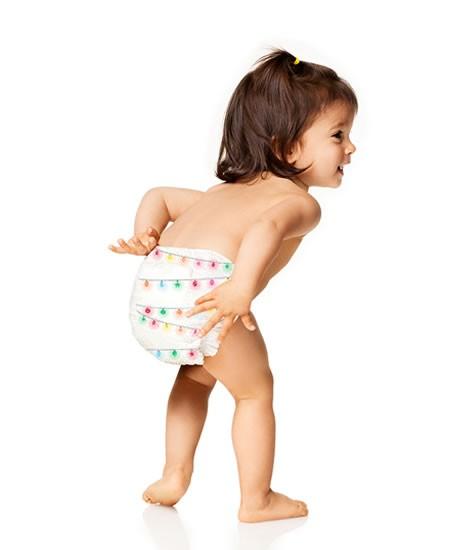
How to use it correctly
Reusable diapers with inserts help the baby stay dry for several hours and do not cause allergies, diaper rash or irritation on the skin of newborns if the mother knows how to use such products correctly.
It is necessary to take into account the absorbency of the inserts, the amount of fluid released, and the age of the child. In order not to get confused by “technical difficulties”, we advise you to use our recommendations.
How to wear
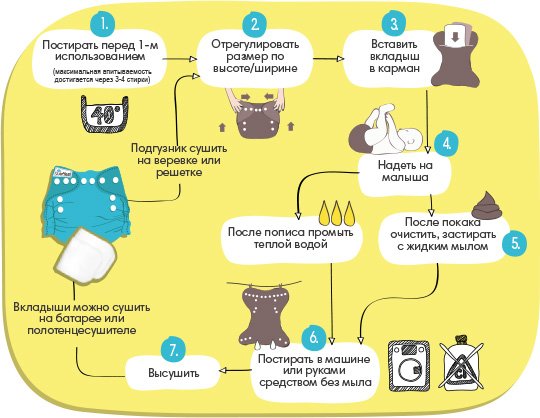
This is easy to do, follow the instructions:
- Lay out your panties on the table and unfasten all fasteners.
- Place the liner in the pocket of your swimming trunks. Carefully straighten it so that there are no wrinkles. Newborn babies do not need to put a pad in the pocket. Babies under 3 months often pee, so the liner is placed on top of the inside of the panties.
- Place the baby on the diaper.
- Adjust the position of your butt so that the back of the panties does not go too high or low on the back.
- Place the front of the panties up between the legs.
- Fasten the rivets.
- Check that the size is adjusted correctly according to the stomach, in the girth of the legs, so that the product does not fall off, does not sting, and there are no large gaps between the hips and the fabric.
- When the time comes to replace the panties with clean ones, do not forget to dry the baby's bottom, if possible, wash the body under running water and apply moisturizer.
On a note! To make practice easier, watch a video on how to use reusable diapers with inserts.
How to adjust the size
The size of reusable diapers is adjustable using fasteners. Newborns need to fasten both rows of buttons: top and bottom. As a result, a thick fold forms on the tummy, but it does not bother the baby.
From 4–6 months, the lower buttons are not fixed; if necessary, you can fasten the middle and upper row of fasteners, taking into account the baby’s waist circumference. By the age of one year, only the row that regulates the size of the panties according to the volume of the tummy remains.
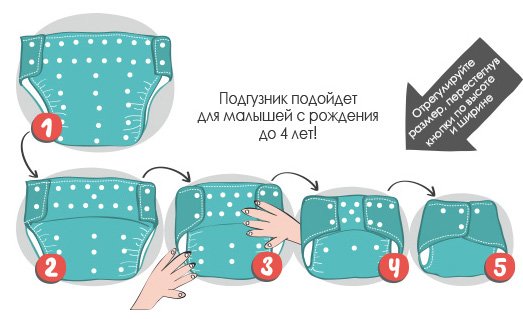
When to replace
For newborns, one pair of panties with an insert is enough for 2-3 hours during the day, 4-5 hours at night. If the baby only pees, watch for leaks and the appearance of the panties, change the diaper as it fills.
After defecation, the trunks and liner must be changed immediately. If you are planning a long walk or visiting, you can increase the service life of the diaper by putting not one, but two inserts in your panties pocket.
Important! Do not force your baby to wear diapers and reusable diapers 24 hours a day. Be sure to give your butt an air bath. Being naked for 30–60 minutes a day is an excellent prevention of diaper rash and itchy skin.
Three methods for weaning your baby off diapers during the day – follow the instructions of experienced mothers!
Don't rush to give diapers to neighbors or friends right away! The process of getting rid of them will be long and difficult, so be patient and find the best way for yourself that will help you and your baby get through this stage quickly and painlessly.
- Method number 1. We stock up on tights (approx. 10-15 pieces) and diapers, and also choose the most luxurious potty that the little one will like. Tights should not be too tight and without tight elastic bands so that the baby can take them off on his own. Introduce the baby to the potty, tell him what to do with it and how. Place your child on the potty and let him try out the new device. In the morning, put tights on your baby and put him on the potty every half hour. If a child pees, do not immediately change the tights - wait 5-7 minutes until the baby himself feels that walking in wet pants is completely uncomfortable. Then take it off, wash your child and put on the next tights. As a rule, this method allows you to give up diapers in a maximum of 2 weeks.
- Method number 2. Let's wean ourselves off diapers through a positive example! Typically, children love to parrot and repeat every word and movement after older children. If your child has older brothers or sisters who already understand the tasks of the potty, then the process of getting rid of diapers will go faster. And if you go to a kindergarten or nursery, then this will be even easier - in such a children's group, potty training occurs regularly, and getting used to new good habits is quick and without whims.
- Method No. 3. All means are good! If there are no older brothers/sisters, don’t worry - use the play method. Every little one has favorite toys - robots, dolls, teddy bears, etc. Plant them in mini pots! And invite your child to sit next to the toys. It will be great if the pots of toys are not empty after such planting - for greater effect. The ideal option is a large baby doll with a potty, capable of writing (they are inexpensive today, and you can spend money on something like this).
All these methods are good for giving up diapers during the day .
Don’t forget to ask your child more often about his intention to murmuring on the potty, don’t rush to change wet pants, use gauze diapers if you’re tired of cleaning up puddles.
As for walking, take 2-3 sets of replacement pants with you if it’s summer outside. In other seasons, it is recommended to wear diapers so as not to catch the child’s cold. Experts advise starting to give up diapers at the beginning of summer.
And don’t forget about the baby’s mood! If the baby is capricious, do not put pressure on him, wait a day or two.
Tips and methods on how to easily wean your child off diapers

Practical recommendations on how best to wean your child off diapers and potty train him.
Method 1. Ten tights
First, you need to prepare yourself to be prepared for the fact that within one or two weeks the diaper will be used only at night and during walks.
Be sure to buy a potty for your child. Prepare clean pants; you will need at least 10 pairs of them. At the same time, you need to choose ones in which the child is comfortable, so that they do not slip and can be easily removed, i.e. The elastic band should be moderately tight.
In the morning you need to put dry tights on your baby and tell him that today he will go without a diaper. And when he wants to go to the toilet, he will certainly have to say so himself, or sit on the potty on his own.
Of course, in the first days the baby will get his tights dirty, because... I'm not used to it yet. At this time, parents will need patience and understanding. You need to leave him in wet tights for a few minutes so that he feels discomfort. Then he needs to be washed and changed into clean and dry pants. At the same time, you definitely need to make sure that the temperature in the room is high enough so that the baby does not catch a cold. You need to endure the inconvenience for 3-4 days. After this, the baby will begin to understand that he needs to ask to go to the potty. And after 7-8 days he will learn to sit on the potty on his own. This method is the most effective. Its negative aspects are that the child will be wet for some time, which, of course, is undesirable. In addition, you will need to wash a lot of tights and panties, as well as wipe up the child’s puddles.
Method 2. Positive example
This method involves teaching children to make it clear that they want to go to the toilet by pointing to older children in the family, neighbor kids, friends, etc. It is necessary to explain to the child that he does not need a diaper, because other children have not worn one for a long time. The baby will begin to try to imitate them. As a result, he will no longer want to wear diapers and will quickly get used to doing without them. At the same time, a child who goes to kindergarten or nursery is more likely to wean himself off the habit. If you point out to your baby that other children do not wear diapers and sit on the potty on their own, this will actively encourage him to do the same. And he will learn to ask to go potty.
Method 3. Using toys
If there are no other children, and if the child does not go to kindergarten, the play method should be used. To do this, you need to take one of your favorite toys and tell the child: now, she has grown up a long time ago and does not wear diapers. And then put this toy on the potty. After this, invite the child to sit down and go to the potty himself. At the same time, so that he does not jump up, you can read him a book. Such an exciting game will become clear to the baby, and he will remember that he needs to ask to go to the potty when he wants to go to the toilet. And he will begin to wean off diapers much faster.
Whatever method is used, you definitely need to praise the child more often for any, even minor, little things. This will help him understand that he is behaving as he should, and he will really want to hear praise again.
We act in exactly the same way - just don’t forget about the rules:
- Let's take our time, don't look at our neighbors and friends! Every family has its own experience! If one child sits on the potty on his own at 10 months and by the age of one and a half years wakes up dry even after a night, then another may have a hard time even at 3 years. Therefore, focus on your child’s readiness to wean off diapers.
- Don't be a tyrant. Start only when the child is ready.
- Limit fluid intake before bed.
- If the baby tosses and turns in his sleep, whines, or wakes up , we put him on the potty.
- Before putting him in the crib, we put him on a potty.
- Immediately after waking up, we put him on the potty. Regardless of whether the little one woke up wet or not.
- Keep a change of clothes, pajamas and wet wipes ready. If you drag your child to the bathroom in the middle of the night, it will take a long time to put him to bed again. It is recommended to place a chamber pot nearby. If the child already gets out of bed on his own, he will quickly master the potty and will find it himself near the crib at night.
- Be sure to leave a night light. Not bright - with soft and diffused light.
- Form a cause-and-effect relationship. The baby should remember about the potty as soon as the urge to urinate appears. And do not make it easier for him to sleep at night - the child must remember that sleeping in wet diapers is unpleasant.
- Find an oilcloth that won't cool down too quickly after a wet job. Ordinary medical oilcloths are very cold. There are children's versions of oilcloths on which the butt will not freeze immediately after an “accident”.
- Stick to your plan. If you have started giving up diapers, stay on track. Yes, there will be sleepless nights, a lot of laundry and nerves, but the result will be a reward for both you and the baby. And it won’t keep you waiting long if you do everything right.
And most importantly, praise your child for dry pants and a dry bed. Let the little one remember what he can do to please his mother.
